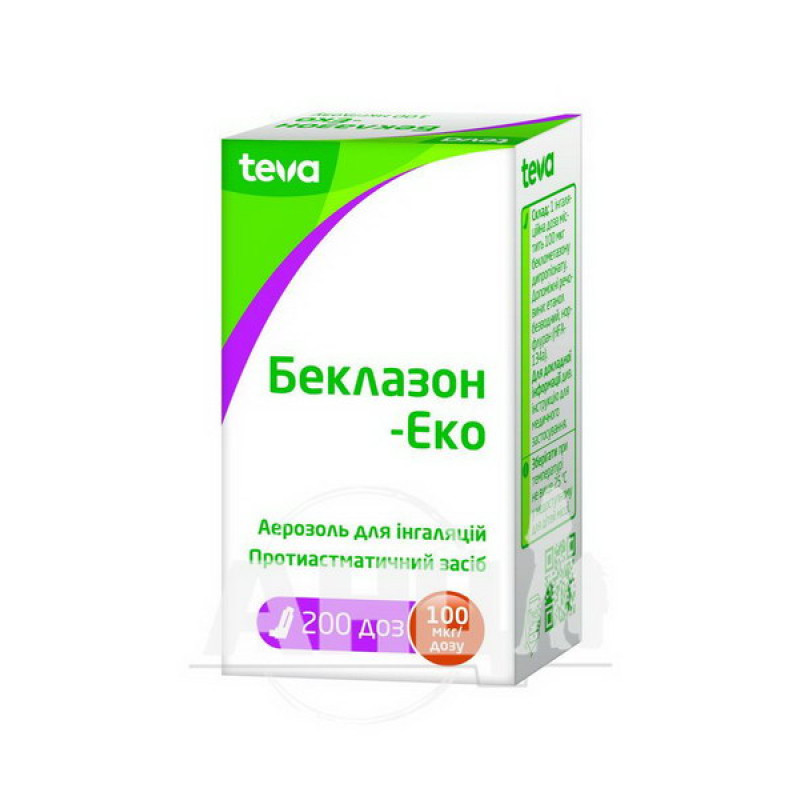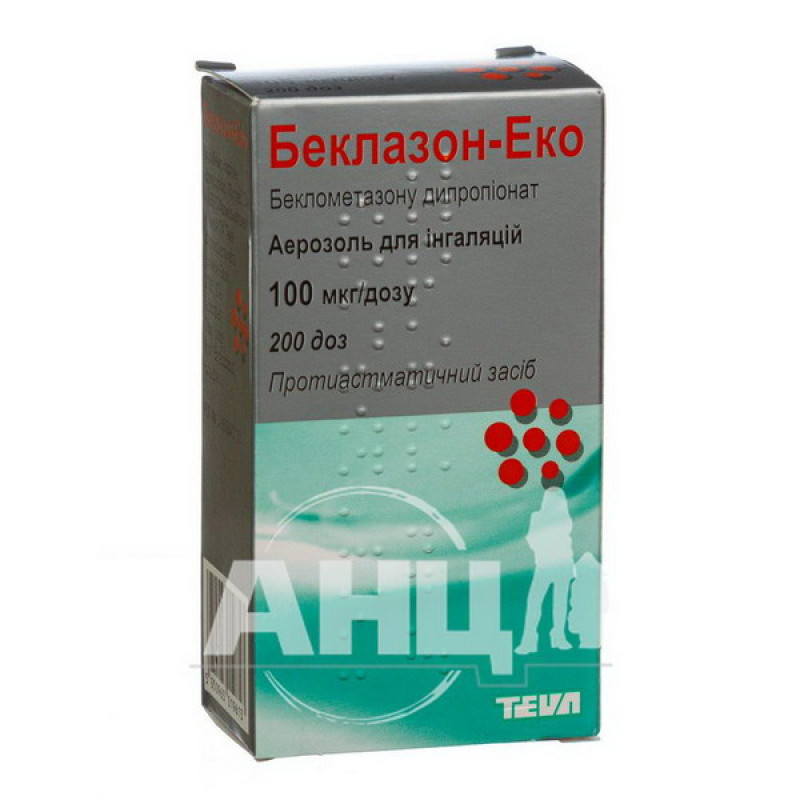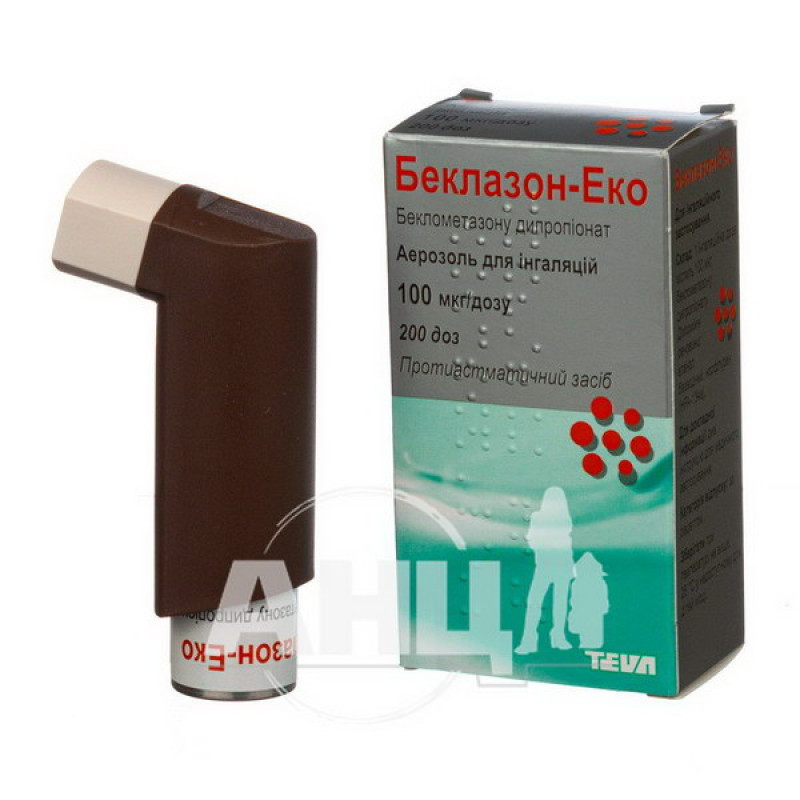Beklazon-Eco inhalation aerosol 100 mcg/dose canister 200 doses with inhalation device

Pharmacological properties
Pharmacodynamics. Beclomethasone dipropionate is a precursor of the active substance with a weak affinity for GCS receptors. It is hydrolyzed by esterases to form the active metabolite beclomethasone-17-monopropionate, which has high local anti-inflammatory activity.
Pharmacokinetics. When inhaled, systemic absorption of unchanged beclomethasone dipropionate occurs through the lungs with little oral absorption of the dose delivered to the gastrointestinal tract. Before absorption, beclomethasone dipropionate is extensively converted to its active metabolite beclomethasone-17-monopropionate. Systemic absorption of beclomethasone-17-monopropionate consists of absorption in the lungs and in the gastrointestinal tract. Absolute bioavailability when inhaled is approximately 60% of the administered dose for beclomethasone-17-monopropionate.
Beclomethasone dipropionate is rapidly eliminated from the systemic circulation by esterase-mediated metabolism. The main metabolic product is the active beclomethasone-17-monopropionate.
The volume of distribution of beclomethasone dipropionate in the plateau phase is moderate (20 L), but that of beclomethasone-17-monopropionate is greater (424 L). Protein binding is moderately high (87%).
Beclomethasone dipropionate and beclomethasone-17-monopropionate have high plasma clearance (150 and 120 l / h), T ½ are 0.5 and 2.7 hours. Approximately 60% of the drug dose is excreted in the feces, 12% - in the urine in the form of free and conjugated polar metabolites. Renal clearance of beclomethasone dipropionate and its metabolites is insignificant.
Indication
Beclazon-eco, 100 mcg: preventive treatment for chronic mild, moderate and severe acne.
Beclazon-Eco, 250 mcg: treatment of severe asthma in adults, as well as treatment of patients who require the use of systemic steroids for adequate control of asthma symptoms.
Application
The drug is prescribed only for oral inhalation. The therapeutic effect is observed after treatment for several days and reaches a maximum after 2-3 weeks. When transferring a patient from other inhalation drugs to Beklazon-eco, it is necessary to leave the same dose of beclomethasone dipropionate, which is subsequently determined individually.
Beclazon-Eco, 100 mcg. For optimal results, Beclazon-Eco should be used regularly. The initial dose should correspond to the severity of the disease.
The minimum dose that provides effective control of asthma should be established.
Adults and children over 12 years of age: the initial dose is 100 to 500 mcg/day (maximum daily dose is 1000 mcg), depending on the severity of the patient's asthma.
The maintenance dose is usually 200-400 mcg, evenly distributed throughout the day. If necessary, higher doses, up to 1000 mcg per day, can be used.
Children aged 7-12 years: the initial dose is 100 mcg 2 times a day (maximum daily dose is 200 mcg), depending on the severity of the patient's asthma.
If asthma symptoms remain satisfactory, the dose can be gradually reduced to the minimum effective dose that provides effective asthma control.
Beclazon-Eco, 250 mcg. Patients should be aware that Beclazon-Eco should be used for the prevention of the disease and therefore it should be used regularly, even in the absence of asthma attacks.
The dose of the drug is adjusted depending on the individual response.
If the improvement in the condition after the use of short-acting bronchodilators becomes less effective or a larger number of inhalations than usual are required, the treatment should be reviewed.
The initial dose should be appropriate for the severity of the disease. For patients requiring high doses of inhaled corticosteroids, the initial dose should be 1000 mcg/day. The dose can then be adjusted until asthma symptoms are controlled or reduced to the minimum effective dose, depending on the individual patient's response.
Adults and children over 12 years of age (including elderly patients) 1000 mcg/day; the dose may be increased to 2000 mcg/day. After stabilization of the patient's condition, the dose may be reduced. The daily dose may be administered in 2; 3 or 4 divided doses.
To obtain optimal results, Beclazon-Eco must be used regularly, even in the absence of symptoms.
Instructions for using inhalers
Check the operation of the inhaler before using it.
1. Remove the cap from the inhaler. Make sure that there is no dust or dirt in the outlet tube.
2. Hold the can upright with your index finger on the bottom and your thumb on the top of the can. Shake the can vigorously up and down.
3. Exhale as fully as possible (without straining). Close your lips tightly around the outlet tube of the canister. Take a slow, deep breath in. At the moment of starting to inhale, press your index finger on the bottom of the canister, releasing a dose of medication. Continue to inhale slowly and deeply.
4. Remove the inhaler tube from your mouth and hold your breath for 10 seconds or as long as you can do without straining. Exhale slowly.
5. If you need to take more than one dose of medication, wait about 1 minute and then repeat the action, starting from step 2. Put the cap back on the inhaler.
Do not rush when performing step 3. It is important to inhale as slowly as possible when releasing the dose.
1. Remove the aluminum can from the plastic case. Avoid contact of the can with water.
2. Remove the protective cap.
3. Rinse the plastic case with the oral applicator with hot water and dry thoroughly (without using direct heat).
4. After drying, put the canister back in the plastic case, close the oral applicator with the protective cap.
The oral applicator should be washed once a week.
Contraindication
Hypersensitivity to beclomethasone dipropionate or to any of the excipients.
Side effects
Infections and infestations: latent/opportunistic infections, candidiasis of the mouth and throat.
Immune system disorders: allergic reactions, including angioedema of the eyes, throat, lips and face; respiratory symptoms (dyspnea and/or bronchospasm with increased wheezing, cough) and anaphylactoid/anaphylactic reactions.
Endocrine disorders: Cushing's syndrome, Cushingoid features, adrenal suppression (systemic effects), growth retardation in children and adolescents.
Visual disorders: cataract, blurred vision, central serous retinopathy, glaucoma (systemic effect).
Respiratory system disorders: hoarseness, throat irritation, paradoxical bronchospasm.
Skin and subcutaneous tissue disorders: urticaria, rash, pruritus, erythema.
Musculoskeletal and connective tissue disorders: decreased bone mineral density (systemic effect).
Psychiatric disorders: sleep disorders, anxiety, depression, aggression, behavioral changes, including hyperactivity and agitation (mainly in children).
Special instructions
Treatment for BA should be carried out according to a phased program, the patient's condition should be regularly monitored both clinically and by determining indicators of external respiratory function.
Increasing the frequency/dose of bronchodilators (especially short-acting inhaled β2-agonists) to relieve asthma symptoms indicates worsening asthma control. In these conditions, therapy should be reviewed. Sudden and progressive deterioration in asthma control is potentially life-threatening, so the dose of corticosteroids should be increased. Peak flowmetry should be performed in patients at risk.
Beclazon-Eco is not intended for the relief of acute asthma attacks, but for long-term preventive treatment. To alleviate the condition during acute asthma attacks, fast-acting and short-acting inhaled bronchodilators should be used.
It is necessary to use the inhaler correctly in order to ensure that the drug enters the bronchi. The actuation of the aerosol should be synchronized with inhalation. Insufficient response to treatment or severe exacerbation of asthma require an increase in the dose of Beclazon-Eco and, if necessary, the use of systemic steroids and / or antibiotics in the presence of infection.
Systemic effects may occur with inhaled corticosteroids, especially at high doses and over long periods of time, but to a lesser extent than with oral steroids. Systemic effects may include Cushing's syndrome, Cushingoid features, adrenal suppression, growth retardation in children and adolescents, decreased bone mineralization, cataracts, and glaucoma. It is therefore important that the dose of inhaled corticosteroids be reduced to the lowest dose at which effective control of asthma symptoms is maintained. In such patients, adrenal function should be monitored regularly and the dose of systemic steroid should be reduced with caution. Some patients experience malaise (i.e., headache, nausea, joint or muscle discomfort) during the withdrawal phase, despite maintained or even improved respiratory function. They should be encouraged to continue inhalation and to discontinue systemic steroid, unless there is objective evidence of adrenal insufficiency. It is recommended to regularly monitor the growth of children who are receiving long-term treatment with inhaled corticosteroids.
There is individual hypersensitivity to inhaled corticosteroids.
Transferring patients from oral corticosteroids to Beclazon-Eco requires special attention and constant monitoring of adrenal function, mainly because the recovery of adrenal cortical dysfunction caused by prolonged systemic steroid treatment is slow. The patient's condition should be moderately stable before starting Beclazon-Eco inhalation as an addition to the usual maintenance dose of systemic steroid. After approximately 1 week, the systemic steroid is gradually withdrawn, reducing the daily dose by 1 mg of prednisolone or its equivalent for other corticosteroids, at intervals of at least one week.
Spirometric and clinical assessment should be used when reducing doses during oral GCS use. Most patients can be successfully transferred to Beclazon-Eco with maintenance of adequate respiratory function, but special caution is necessary in the first months after the transition, until the hypothalamic-pituitary-adrenal function has recovered sufficiently to allow the patient's body to cope with unforeseen events such as trauma, surgery or infections.
The process of switching to Beclazon-Eco and stopping systemic therapy should be gradual and patients should carry a special card with a warning about the need for additional administration of systemic steroid during stressful periods, for example, during a severe asthma attack, severe intercurrent diseases, surgical interventions, injuries, they should also be given a supply of oral steroids for use in unforeseen cases, for example, when worsening of asthma symptoms as a result of an infection localized in the chest area. The dose of Beclazon-Eco should be increased at this time, and after stopping the systemic steroid, it should be reduced to a maintenance level.
Similarly, switching from systemic steroid therapy to inhaled steroid therapy can sometimes unmask allergic conditions, such as allergic rhinitis or eczema, that were previously controlled by systemic steroids. These allergic manifestations should be treated with antihistamines and/or topical medications, including corticosteroids.
Do not stop treatment with Beclazon-Eco suddenly!
Patients with high levels of Candida precipitins in the blood, indicating a history of infection, are more likely to develop candidiasis of the mouth and throat (candidiasis stomatitis). All patients may find it helpful to rinse their mouth with water after using the inhaler.
As with other inhaled medications, paradoxical bronchospasm with rapidly increasing dyspnea after inhalation may occur. In such cases, rapid-acting inhaled bronchodilators should be used immediately, Beclazon-Eco inhalation should be stopped immediately, the patient should be examined and, if necessary, alternative therapy should be prescribed.
Patients should also be advised that Beclomethasone dipropionate will need to be used regularly to obtain optimal results, even if they are asymptomatic. Patients treated with Beclomethasone dipropionate 100 mcg/dose may be switched directly to Beclomethasone dipropionate 250 mcg/dose (at the same total daily dose, if necessary increasing the dose to a maximum daily dose of 1000 mcg). In most patients, no significant effect on plasma or urine free cortisone levels is observed until a dose of 1000 mcg/day is exceeded. In some patients receiving 2000 mcg/day of beclomethasone dipropionate, a decrease in plasma or urine free cortisone levels has been observed, although short-term adrenal reserve remains unchanged. In any patient, the risk of adrenal suppression should be weighed against the therapeutic benefits, and measures should be taken to provide support with systemic steroids in situations of prolonged stress.
As with other inhaled corticosteroids, special caution is required when prescribing Beclazon-Eco to patients with active and latent pulmonary tuberculosis. Treatment with corticosteroids may mask the symptoms of pulmonary tuberculosis and other bacterial, viral and fungal infections of the respiratory tract. Reactivation of pulmonary tuberculosis is possible. If the drug is prescribed to patients with concomitant respiratory tract infections, they should be treated appropriately. The drug should be used with restrictions for the treatment of patients with lung abnormalities, such as bronchiectasis and pneumoconiosis due to the possibility of fungal infection. After using the drug, the oral cavity should be rinsed with water.
The drug should not be prescribed to patients with herpes simplex and asthmatic status. Particular care should be taken to minimize the use of local corticosteroids in patients with immunosuppression.
The drug should be used with caution in patients with viral, bacterial and fungal infections of the eye or mouth, as well as the respiratory tract. In the case of a bacterial infection of the respiratory tract, the use of an appropriate antibiotic may be necessary.
Patients should be warned that the drug contains a small amount of ethanol. In therapeutic doses, the amount of ethanol is extremely small and does not pose a risk to patients.
The aerosol can contains a liquid under pressure from compressed gas, so it must not be stored at temperatures above 50 °C, pierced or broken, even when it is probably empty. Do not refrigerate or freeze.
Medicines that are no longer needed should be disposed of in accordance with the internal disposal regulations for this type of product. These measures will help protect the environment.
Use during pregnancy or breastfeeding. The safety of Beclazon-Eco during pregnancy has not been definitively established. Inhalation of beclomethasone may be accompanied by intrauterine growth retardation of the fetus. When deciding whether to use beclomethasone during pregnancy, the ratio of the expected benefit to the mother and the potential risk to the fetus should be weighed.
Beclomethasone passes into breast milk, but in very small quantities. The appointment of the drug during breastfeeding should be considered taking into account the fact that the therapeutic benefit of using the drug should outweigh the possible risk to the fetus.
Beclazon-Eco 250 mcg is not recommended for use in children under 12 years of age.
The ability to influence the reaction speed when driving vehicles or working with other mechanisms. Does not affect.
Interactions
Concomitant use of barbiturates, phenytoin or rifampicin may increase the metabolism and reduce the effectiveness of oral corticosteroids. The response to anticoagulants may be reduced and in some cases increased due to the action of oral corticosteroids. Concomitant use of oral corticosteroids or non-potassium-sparing diuretics such as thiazides or furosemide may cause excessive potassium loss. No interactions have been reported with Beclazon-eco.
Beclazon-Eco contains a very small amount of ethanol, so theoretically, in patients with hypersensitivity, interaction is possible when taken simultaneously with disulfiram or metronidazole.
Overdose
The acute toxicity of Beklazon-eco is very low. The only harmful effect after inhalation of a large number of doses for a short time is a temporary suppression of the hypothalamic-pituitary-adrenal function. In this case, no special measures are required. Treatment should be continued at the recommended dose. Restoration of the hypothalamic-pituitary-adrenal function occurs within 1-2 days.
However, when the drug is used in doses exceeding the recommended ones for a long time, some suppression of adrenal function is possible in addition to suppression of the hypothalamic-pituitary-adrenal function. In such cases, it is necessary to check the adrenal reserve. The patient should be treated as a steroid-dependent and transferred to an appropriate maintenance dose of a systemic steroid, such as prednisolone. As soon as the patient's condition is stabilized, he should be transferred to Beklazon-Eco in the manner described in the section Features of use.
There is no specific treatment for overdose with beclomethasone dipropionate. In case of overdose, supportive therapy should be provided with appropriate monitoring if necessary. Further treatment should be according to the clinical situation or according to local recommendations, if available.
Storage conditions
At a temperature not exceeding 25 °C.
There are no reviews for this product.
There are no reviews for this product, be the first to leave your review.
No questions about this product, be the first and ask your question.










